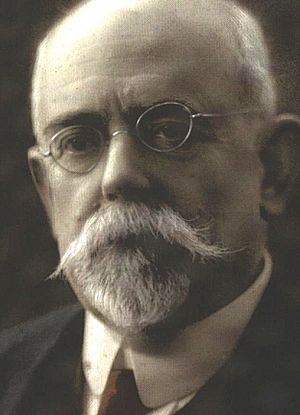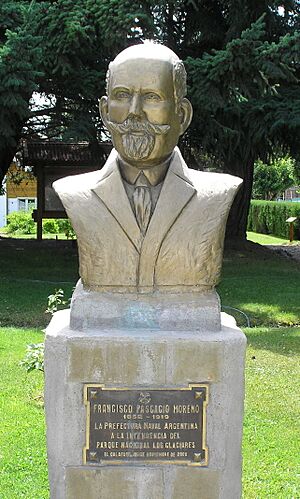Francisco Moreno facts for kids
Quick facts for kids
Francisco Moreno
|
|
|---|---|

Francisco P. Moreno
|
|
| Born |
Francisco Pascasio Moreno
May 31, 1852 Buenos Aires, Argentina
|
| Died | November 22, 1919 (aged 67) Buenos Aires, Argentina
|
| Nationality | Argentine |
| Known for | Exploration of the Patagonia |
| Awards | Founder's Medal (1907) Cullum Geographical Medal (1909) |
Francisco Pascasio Moreno (born May 31, 1852 – died November 22, 1919) was an important explorer and scientist from Argentina. People often called him Perito Moreno, which means "expert" or "specialist." He played a big part in exploring and helping Argentina claim large areas of Patagonia.
Contents
Life and Early Explorations
Francisco Moreno was born in Buenos Aires to Francisco and Juana Thwaites Madero. He grew up in a well-known family and went to local schools. From a young age, he loved exploring with his father. They often looked for old artifacts and fossils. By the time he was 14, he had so many items that he created his own museum at home!
Exploring Patagonia's Wild Lands
After finishing school in 1872, Moreno helped start the Argentine Scientific Society. He then began his first major scientific trips. He explored the Río Negro Territory, which was mostly unknown land at the time.
In January 1876, he reached Lake Nahuel-Huapi in the southern Andes mountains. A year later, on February 15, 1877, he discovered and named Lake Argentino. He also explored many rivers in Patagonia. On March 2, he discovered and named Mount Fitz Roy. He named it after the commander of the HMS Beagle expedition from the 1830s. Local people also called this mountain Chalten.
Adventures and Discoveries Abroad
In 1880, Moreno traveled to France. He gave a speech in Paris about two ancient skulls he found in the Río Negro territory. He believed one skull was from a very old time period. The other showed signs of being shaped in a way similar to the skulls of the Aymara people from the Andes.
After returning to Argentina, he went on another big trip to Patagonia. During this journey, a Tehuelche tribe captured him. He was sentenced to death but managed to escape on March 11, just one day before he was to be executed. While with the tribe, he met their chief, Inacayal, who treated him kindly.
More Explorations and Recognition
Between 1882 and 1883, Moreno explored the Andes mountains, going south from Bolivia. In 1884 and 1885, he explored more areas south of the Río Negro and in Patagonia. He was chosen to lead Argentina's exploration team for the southern territories. He also became a member of many scientific groups in Europe. For all his work, he received an honorary doctorate from the National University of Córdoba in 1877.
Moreno was also very important in protecting Argentina's land. He made detailed maps and surveys that helped create the Boundary treaty of 1881 between Chile and Argentina. Because of his important work, the famous Perito Moreno Glacier in Argentina was named after him. His explorations helped him collect many ancient artifacts and information about people. He used these to start an anthropology museum in Buenos Aires in 1877.
Museum Director and "Perito"
In 1888, Moreno started the La Plata Museum of Natural History. This museum became the most important of its kind in South America. Moreno's collections at this museum helped show Argentina's history and its claims to its land. He brought items from faraway places to be studied at the museum. This helped create a national story for Argentina. Moreno was the first director of the La Plata Museum, leading it until 1906.
Solving Border Disputes
In 1902, Moreno was given the title of Perito, meaning "expert." In this role, he helped settle border disagreements with Chile. He showed that many lakes in Patagonia that seemed to drain into the Pacific Ocean were actually part of the Atlantic Ocean's water system. This was because during past ice ages, glaciers had blocked these lakes, changing how their water flowed.
Protecting Nature and Helping Education
In 1903, Moreno gave away some land he owned to create the Nahuel Huapi National Park. This was Argentina's first national park, showing his love for nature. In 1911, he became an assistant director for the National Education Council. He helped get money for the Bernasconi Institute, an important primary school in Buenos Aires. This school was built on land Moreno sold. Its museums were also started with many of his collected items.
Moreno also started the Argentine Boy Scouts Association in 1912. He even toured Patagonia with former U.S. President Theodore Roosevelt. He continued to be involved with the La Plata Museum even after he officially retired.
Francisco Moreno passed away in 1919. His remains were later moved and reburied on Centinela Isle in Lake Nahuel Huapi. A type of Argentinian lizard, Liolaemus morenoi, is named in his honor.
Images for kids
See also
 In Spanish: Francisco Pascasio Moreno para niños
In Spanish: Francisco Pascasio Moreno para niños




